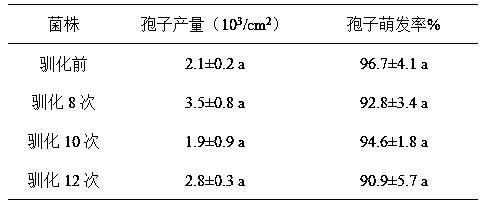Method for enhancing weeding toxicity of bipolarisgraminus spores
A technology for spores of Helicobacter flatus and Helicobacter flatus, which is applied in the field of microorganisms, can solve the problem that field herbicidal toxicity cannot meet production requirements, etc., and achieves good herbicidal toxicity, increased pathogenicity, and improved pathogenicity. Effect
- Summary
- Abstract
- Description
- Claims
- Application Information
AI Technical Summary
Problems solved by technology
Method used
Image
Examples
Embodiment 1
[0030] (1) Inoculate Helminthromyces barnyardii on a PDA plate, culture it upside down in the dark at 28°C for 14 days, wash the spores with sterile 0.05% Tween-20 solution, and prepare a concentration of 1×10 5 individual / mL spore suspension.
[0031] (2) Put 25g of barnyard barnyardgrass seeds in a 250mL triangular flask, sterilize at 121°C for 30min, cool and inoculate the spore suspension obtained in step (1), 10mL per bottle, inoculate 3 bottles.
[0032] (3) Put the triangular flask in the incubator, and after cultivating in the dark at a constant temperature of 28°C for 10 days, collect the spores and inoculate the barnyardgrass seeds 10 times for domestication.
[0033] (4) Take 50 μL of the spore suspension acclimatized for 10 times and drop it on the PDA plate, streak it with an inoculation loop, and incubate at a constant temperature of 28°C for 5 days.
[0034] (5) Select the single colony of P. barnyardiae that was cultured by streaking on the petri dish, take th...
Embodiment 2
[0037] Example 2: Safety evaluation of 0.05% Tween-20 spore suspension after domestication on main crops.
[0038]Seedlings of rice (Xiushui 134, Zhongzao 39, Zheyou 18), wheat, corn, sorghum, soybean, broad bean, cotton and rapeseed were grown in pots and pots respectively. Spray domesticated and pre-domesticated spore suspensions when graminaceous plants have 2 leaves and 1 heart and dicotyledonous plants have 2 true leaves, and the number of inoculated spores per square meter is 4×10 7 . After inoculation, they were placed in an incubator and incubated in the dark at 28±0.5°C (RH95%) for 24 hours, then moved to a greenhouse at 28±2°C, and sprayed to moisturize for the first 2 days. The disease incidence was investigated 7 days after inoculation. The 0.05% Tween-20 solution without spores was used as the negative control (crops were not susceptible to the disease), and barnyardgrass without awns was used as the positive control (barnyardgrass was susceptible). Each treatme...
Embodiment 3
[0043] Example 3: Evaluation of the pathogenicity of 0.05% Tween-20 spore suspension after domestication to different species of barnyardgrass.
[0044] The seeds of barnyard barnyardgrass, barnyard barnyardgrass, barnyard barnyardgrass, barnyard barnyardgrass, paddy field barnyardgrass, Hunan barnyard barnyardgrass and purple ear barnyardgrass were planted in pots and pots respectively after germinating, sprayed and inoculated 10 times at the 2-3 leaf stage and domesticated For the previous spore suspension, the number of inoculated spores per square meter is 4×10 7 . After inoculation, they were placed in an incubator and incubated in the dark at 28±0.5°C (RH95%) for 24 hours, then moved to a greenhouse at 28±2°C, and sprayed to moisturize for the first 2 days. The disease incidence was investigated 7 days after inoculation. Taking the 0.05% Tween-20 solution without adding spores as the control, each treatment was repeated 3 times, and the results are shown in Table 2 bel...
PUM
 Login to View More
Login to View More Abstract
Description
Claims
Application Information
 Login to View More
Login to View More - R&D
- Intellectual Property
- Life Sciences
- Materials
- Tech Scout
- Unparalleled Data Quality
- Higher Quality Content
- 60% Fewer Hallucinations
Browse by: Latest US Patents, China's latest patents, Technical Efficacy Thesaurus, Application Domain, Technology Topic, Popular Technical Reports.
© 2025 PatSnap. All rights reserved.Legal|Privacy policy|Modern Slavery Act Transparency Statement|Sitemap|About US| Contact US: help@patsnap.com



